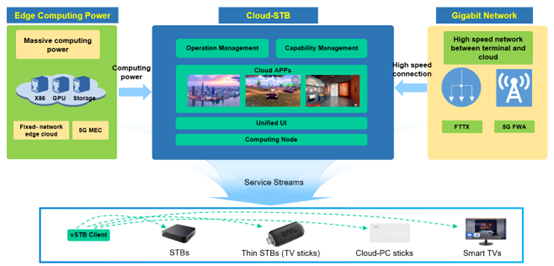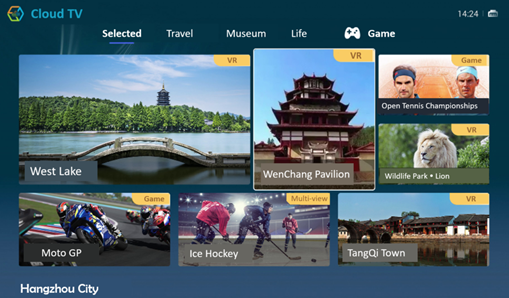ZTE vSTB to reshape what TV services look likeZTE vSTB to reshape what TV services look like
September 14, 2023

Cloud-based terminals and applications like cloud PCs, cloud phones, cloud gaming, and cloud VR, which are growing increasingly popular, have proved their value in accelerating the uptake of new services, saving investment in terminals while improving operation and maintenance efficiency. In the TV industry, after decades of development, the existing set-top boxes (STBs) have increased to a huge number, posing enormous upgrade and replacement challenges. The cloud terminal technology has proven to possess a great potential in this field.
In line with such a background, ZTE launched the virtual STB (vSTB) solution. With cloud-based services and terminal decoupling, vSTB completely breaks through the terminal bottleneck that restricts the development of TV services, solves the pain points of low service quality, poor user experience, difficult service adaptation, and large terminal investment encountered during the development of operators’ TV services, and helps operators rapidly develop high-quality value-added TV services. The solution will bring about major transformation in the STB field, reshape the TV industry, and create more business opportunities in the future.
China Mobile is the largest mobile, fixed-line and IPTV operator in China with 200 million IPTV STB subscribers. In recent years, leveraging its rich edge IDC and network resources, China Mobile has built a huge edge cloud network with increasingly powerful computing capabilities. Based on the vSTB solution, ZTE, together with China Mobile and other business partners, created China Mobile’s “Cloud-STB” product, which includes six major components: cloud APP, computing node, capability management, client software, unified UI, and operation management.

Figure 1 Cloud-STB
Cloud-STB leverages China Mobile’s powerful computing capabilities of fixed-line edge cloud and 5G MEC to deploy solution components. It can be deployed flexibly on cloud hosts, OLT’s computing boards, and MEC devices. With FTTX and 5G FWA network, Cloud-STB can stream a wide variety of TV applications, such as VR, multi-dimensional video and interactive fitness, to various terminals. With specially designed low-latency two-way interactive transfer protocol, it is well adapted to various network conditions such as optical networks, copper networks, and 5G FWA, delivering a great service experience. Cloud-STB also supports terminals like traditional STBs, thin STBs (TV sticks), cloud PC sticks, and smart TVs, enabling users to enjoy an intelligent digital life with their existing terminals by simply installing a client software. So far, the Cloud-STB subscribers have reached 20 million, accounting for 1/10 of China Mobile’s total IPTV users.

Figure 2 Cloud-STB UI
It can be seen from the case above that vSTB addresses many pain points of the traditional STBs. First, by moving services to the cloud, it extends the life cycle of STBs, thus saving considerable investment in STB replacement for operators. For example, China Mobile spends billions of CNY on replacing legacy STBs every year, which can be reduced to 1/10 of the original if vSTB is fully deployed. Second, the unified UI shields the underlying differences of STBs, which greatly improves the efficiency of service operation and maintenance. Millions of STBs can be upgraded within one day, and network-wide deployment of new services can be completed within one week. Third, leveraging edge computing, vSTB transcends the performance limitations of traditional TV terminals, allowing them to smoothly run high performance computing applications, such as cloud games, cloud VR, multi-viewpoint video, and free-viewpoint video. This greatly enriches the IPTV ecosystem and unlocks new revenue streams for operators. In terms of user experience, via analyzing and optimizing user usage habits, vSTB providing intelligent UI layout and content recommendations, and improving EPG logic, thus the user experience is continuously improved.
In addition to mining significant value for operators and users, the solution itself presents significant advantages in various aspects compared to similar solutions. First, for the virtualization of Android APK, ZTE adopts the cloud-based X86-based approach, which is more economical and accessible than the ARM computing. Second, ZTE’s soft GPU solution can use X86 CPU for normal 2D rendering without the hardware GPU card. That is to say, ZTE’s vSTB can move non-3D applications (3D applications: cloud gaming, VR, free-viewpoint video, etc.) to the cloud at a very low cost. Third, ZTE’s vSTB supports offloading in-app video playback in the cloud. It sends video URLs to terminals for direct decoding, with only UI rendering and streaming in the cloud. In this way, video quality loss due to decoding and recoding can be avoided, while computing consumption in the cloud and solution costs can be reduced.
About the Author
You May Also Like











.png?width=300&auto=webp&quality=80&disable=upscale)


_1.jpg?width=300&auto=webp&quality=80&disable=upscale)